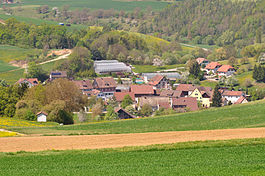Hofen, Schaffhausen
| Hofen | ||
|---|---|---|
| Former municipality of Switzerland | ||
 |
||
|
||
| Coordinates: 47°46′N 8°40′E / 47.767°N 8.667°ECoordinates: 47°46′N 8°40′E / 47.767°N 8.667°E | ||
| Country | Switzerland | |
| Canton | Schaffhausen | |
| District | n.a. | |
| Area | ||
| • Total | 1.05 km2 (0.41 sq mi) | |
| Elevation | 474 m (1,555 ft) | |
| Population | ||
| • Total | 136 | |
| • Density | 130/km2 (340/sq mi) | |
| Postal code | 8242 | |
| SFOS number | 2916 | |
| Surrounded by | Altdorf, Bibern, Opfertshofen, Tengen (DE-BW) | |
| Website | Profile (German), SFSO statistics |
|
Hofen was a municipality in the canton of Schaffhausen in Switzerland. On 1 January 2009 Hofen merged with Altdorf, Bibern, Opfertshofen and Thayngen to form the municipality of Thayngen.
Hofen is first mentioned in 1258 as Hofen.
The blazon of the municipal coat of arms is Gules a Lion rampant Or langued of the first and armed Argent holding in dexter a Fleur-de-lis of the last.
The coat of arms comes from the mayor of Schaffhausen and resident of Hofen, Tobias Holländer (24 February 1636 - 1711). His family came from Holland (the origin of the last name) though he was born in Basel. He became mayor in 1683 and on 18 January 1684 bought land in Hofen and built his manor house, the Holländer's house. Holländer was ambitious and a follower of King Louis XIV of France and he created a personal army in the model of Louis' army. His coat of arms represented his origin and ambition. The lion represents the lion of the Dutch Republic while the fleur-de-lis represents Louis XIV. When he built barracks for his private army in Hofen, he decorated them with his personal coat of arms, which is still visible. His coat of arms became the village coat of arms.
Hofen has an area, as of 2006[update], of 1 km2 (0.39 sq mi). Of this area, 73.1% is used for agricultural purposes, while 8.7% is forested. Of the rest of the land, 16.3% is settled (buildings or roads) and the remainder (1.9%) is non-productive (rivers or lakes). The village is located in the Reiat district in the Biber valley. It is on the border with Baden-Württemberg in Germany, and half way between Opfertshofen, Switzerland and Büsslingen, Germany, on the Swiss Hauptstrasse from Thayngen to Büsslingen.
...
Wikipedia




